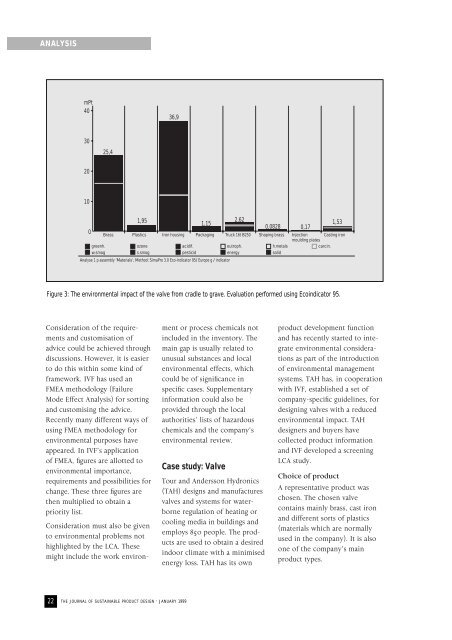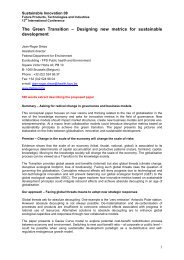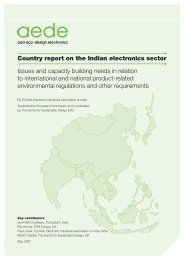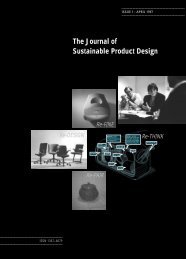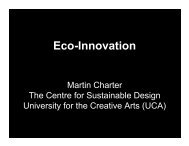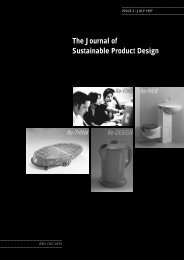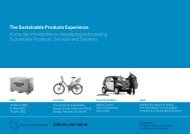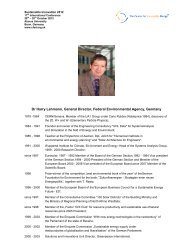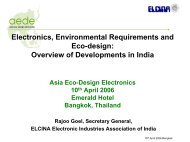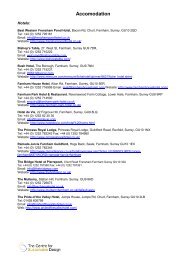acrobat JSPD 8 - The Centre for Sustainable Design
acrobat JSPD 8 - The Centre for Sustainable Design
acrobat JSPD 8 - The Centre for Sustainable Design
Create successful ePaper yourself
Turn your PDF publications into a flip-book with our unique Google optimized e-Paper software.
ANALYSIS<br />
mPt<br />
40<br />
30<br />
20<br />
10<br />
0<br />
25,4<br />
1,95<br />
Figure 3: <strong>The</strong> environmental impact of the valve from cradle to grave. Evaluation per<strong>for</strong>med using Ecoindicator 95.<br />
Consideration of the requirements<br />
and customisation of<br />
advice could be achieved through<br />
discussions. However, it is easier<br />
to do this within some kind of<br />
framework. IVF has used an<br />
FMEA methodology (Failure<br />
Mode Effect Analysis) <strong>for</strong> sorting<br />
and customising the advice.<br />
Recently many different ways of<br />
using FMEA methodology <strong>for</strong><br />
environmental purposes have<br />
appeared. In IVF’s application<br />
of FMEA, figures are allotted to<br />
environmental importance,<br />
requirements and possibilities <strong>for</strong><br />
change. <strong>The</strong>se three figures are<br />
then multiplied to obtain a<br />
priority list.<br />
Consideration must also be given<br />
to environmental problems not<br />
highlighted by the LCA. <strong>The</strong>se<br />
might include the work environ-<br />
36,9<br />
22 THE JOURNAL OF SUSTAINABLE PRODUCT DESIGN · JANUARY 1999<br />
1,15<br />
ment or process chemicals not<br />
included in the inventory. <strong>The</strong><br />
main gap is usually related to<br />
unusual substances and local<br />
environmental effects, which<br />
could be of significance in<br />
specific cases. Supplementary<br />
in<strong>for</strong>mation could also be<br />
provided through the local<br />
authorities’ lists of hazardous<br />
chemicals and the company’s<br />
environmental review.<br />
Case study: Valve<br />
2,62<br />
Tour and Andersson Hydronics<br />
(TAH) designs and manufactures<br />
valves and systems <strong>for</strong> waterborne<br />
regulation of heating or<br />
cooling media in buildings and<br />
employs 850 people. <strong>The</strong> products<br />
are used to obtain a desired<br />
indoor climate with a minimised<br />
energy loss. TAH has its own<br />
0,0828 0,17<br />
Brass Plastics Iron housing Packaging Truck 16t B250 Shaping brass Injection<br />
moulding plates<br />
Casting iron<br />
greenh.<br />
ozone<br />
acidif.<br />
eutroph.<br />
h.metals<br />
carcin.<br />
w.smog<br />
s.smog<br />
pesticid<br />
energy<br />
solid<br />
Analyse 1 p assembly ‘Materials’; Method: SimaPro 3.0 Eco-indicator 95/ Europe g / indicator<br />
1,53<br />
product development function<br />
and has recently started to integrate<br />
environmental considerations<br />
as part of the introduction<br />
of environmental management<br />
systems. TAH has, in cooperation<br />
with IVF, established a set of<br />
company-specific guidelines, <strong>for</strong><br />
designing valves with a reduced<br />
environmental impact. TAH<br />
designers and buyers have<br />
collected product in<strong>for</strong>mation<br />
and IVF developed a screening<br />
LCA study.<br />
Choice of product<br />
A representative product was<br />
chosen. <strong>The</strong> chosen valve<br />
contains mainly brass, cast iron<br />
and different sorts of plastics<br />
(materials which are normally<br />
used in the company). It is also<br />
one of the company’s main<br />
product types.


